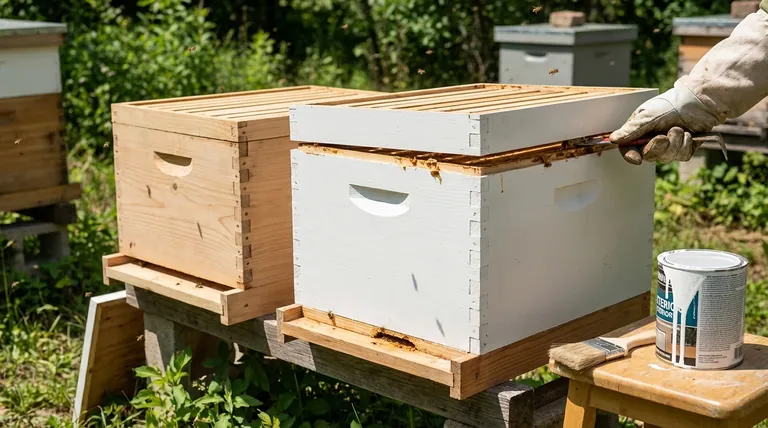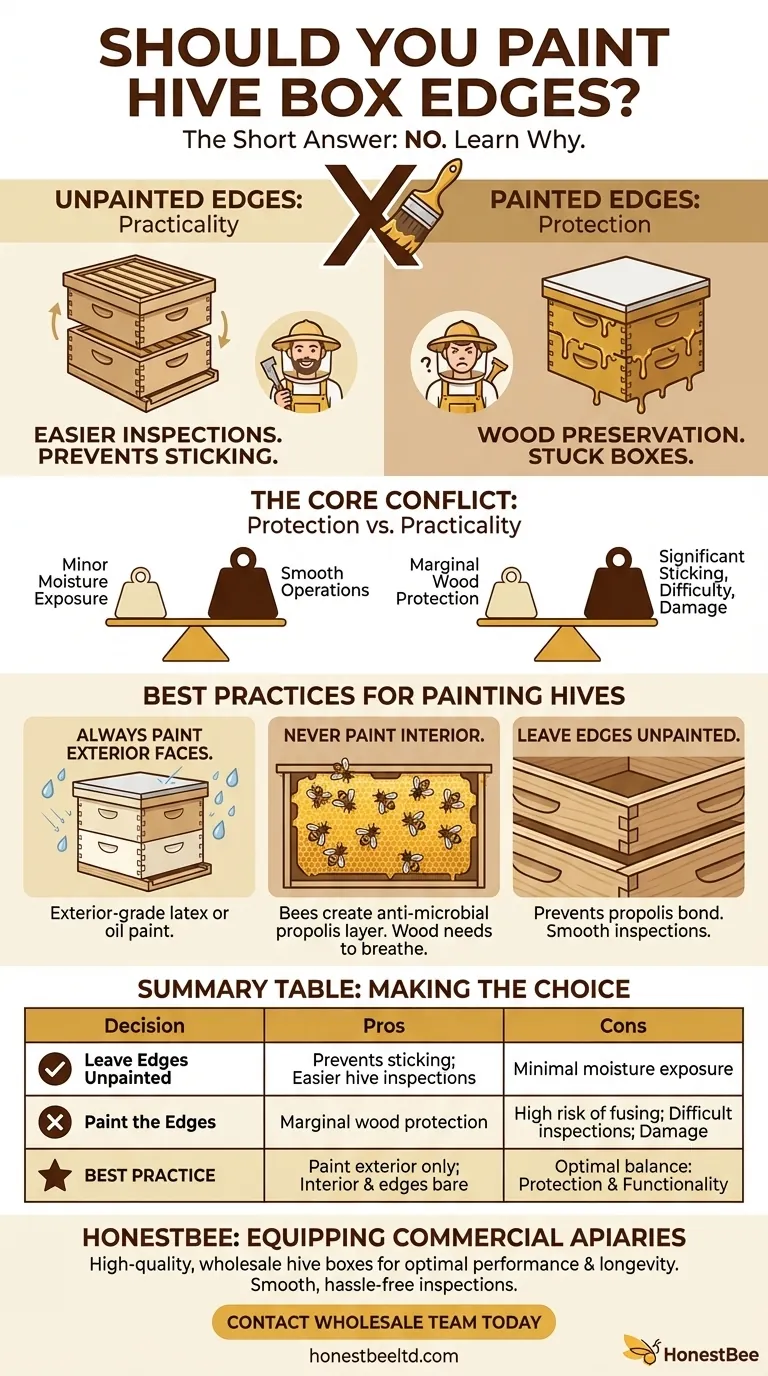In short, no. It is not necessary to paint the top and bottom edges of your hive boxes. The common practice among most beekeepers is to leave these edges unpainted, as painted surfaces pressed together can stick, making hive inspections difficult.
The decision to paint hive box edges comes down to a trade-off: marginal extra wood protection versus the significant practical problem of boxes sticking together. For this reason, the vast majority of beekeepers leave the edges bare.

The Core Conflict: Protection vs. Practicality
When preparing new woodenware, every beekeeper faces the question of how to best protect their investment from the elements while ensuring the hive remains functional. The edges of the boxes are at the center of this debate.
The Case for Leaving Edges Unpainted
The primary reason to avoid painting the top and bottom edges is sticking. Hive boxes are heavy and stacked tightly. Over time, the pressure and heat can cause two painted surfaces to fuse together.
Bees also use a resinous substance called propolis to seal cracks and gaps within the hive. When bees apply this powerful natural glue to painted edges, it creates an exceptionally strong bond that can be very difficult to break.
This sticking makes prying boxes apart during inspections a jarring and difficult task. It can disrupt the colony, anger the bees, and even damage the wood edges of your boxes—the very thing you were trying to protect.
The Argument for Painting Edges
The argument for painting the edges is rooted in wood preservation. These edges contain end grain, which can absorb moisture more readily than the face grain on the sides of the box.
In theory, a coat of paint seals this end grain, offering an additional layer of protection against moisture and potential rot, especially in very wet or humid climates. However, in practice, the operational headaches often outweigh this minor benefit.
Understanding the Trade-offs
Making an informed decision requires weighing the risks and benefits of each approach.
The Risk of Unpainted Edges
The main risk is increased moisture exposure on the end grain. Over many seasons, this could potentially lead to faster degradation of the wood at the corners and edges compared to the painted faces.
However, this risk is often minimal. The tight fit between boxes and the protection from the hive's outer cover already shield these edges from the worst of the weather.
The Problem with Painted Edges
The biggest problem is a significant decrease in ease of use. During a hive inspection, you need to work efficiently and smoothly. Struggling to pry apart boxes wastes time and causes unnecessary vibration and disturbance to the bees.
Using a hive tool to force open stuck boxes can gouge the wood, chip the paint, and ultimately cause more damage than the moisture you were hoping to prevent.
Best Practices for Painting Hives
While the edges are best left bare, proper painting of the rest of the hive is critical for its longevity.
Always Paint the Exterior Faces
All hive components exposed to weather, especially the main exterior walls of the boxes, should receive at least two coats of high-quality paint. This is your primary defense against rain, snow, and sun.
Never Paint the Interior
The inside of the hive should always be left as bare wood. The bees will coat the interior surfaces with a thin, anti-microbial layer of propolis, creating their own ideal and healthy environment. Paint can introduce chemicals and prevent the wood from breathing properly.
Choose the Right Paint
Use a durable exterior-grade latex or oil-based paint. Light colors are standard, with white being the most popular choice. A light-colored hive reflects sunlight, which helps prevent the colony from overheating during hot summer months.
Making the Right Choice for Your Hives
Your decision should be guided by your primary goal as a beekeeper.
- If your primary focus is easy, low-stress hive management: Leave the top and bottom edges of your hive boxes unpainted to prevent them from sticking together.
- If your primary focus is maximizing wood preservation above all else: You can apply a very thin coat of paint, but you must be prepared for the operational challenge of stuck boxes.
- For the balanced, standard approach used by most beekeepers: Paint only the exterior faces of your hive boxes with a light-colored, exterior-grade paint, leaving the inside and the top and bottom edges bare.
Prioritizing a functional and easily managed hive is fundamental to successful and enjoyable beekeeping.
Summary Table:
| Decision | Pros | Cons |
|---|---|---|
| Leave Edges Unpainted | Prevents boxes from sticking; Easier hive inspections | Minimal increase in moisture exposure on end grain |
| Paint the Edges | Marginal extra wood protection | High risk of boxes fusing; Difficult inspections; Potential wood damage |
| Best Practice | Paint exterior faces only; Leave interior and edges bare | Optimal balance of protection and functionality |
Ready to equip your apiary with durable, easy-to-manage hive boxes?
At HONESTBEE, we supply commercial apiaries and beekeeping equipment distributors with high-quality, wholesale-focused beekeeping supplies designed for optimal performance and longevity. Our hive boxes are built to withstand the elements while ensuring smooth, hassle-free inspections.
Let us help you build a stronger, more efficient operation. Contact our wholesale team today to discuss your needs and get a quote!
Visual Guide

Related Products
- Langstroth Bee Hives Bee Keeping Box for Beginners Beekeeping
- Langstroth Honey Bee Box Hive Boxes for Different Depths
- Wholesales Dadant Size Wooden Bee Hives for Beekeeping
- Professional Insulated Plastic Bee Hives
- Long Langstroth Style Horizontal Top Bar Hive for Wholesale
People Also Ask
- Why might a beginner be advised to start with a Langstroth hive? Unlock a Supportive Beekeeping Ecosystem
- Should a beginner try a different type of hive? Start with a Langstroth for a solid foundation.
- Why are Langstroth hives recommended for beginners? Unmatched Support & Standardization
- What basic equipment is needed to start beekeeping? Your Essential Guide to a Confident Start
- What are the different types of beehive boxes available? Choose the Right Hive for Your Apiary



















